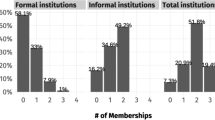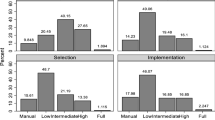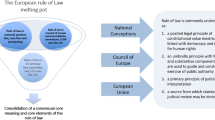Abstract
We exploit variations in access rules on the European Court of Justice to explore the effect of procedural inclusiveness on the agenda of international adjudicators. Using natural language processing methods, we analyze the entire universe of ECJ decisions up to 2015, mapping issue prevalence across time, procedure and litigant type. We find evidence that the more inclusive annulment and referral procedures are associated with greater issue heterogeneity whereas less inclusive infringement procedure displays greater issue cohesiveness as well as greater issue stability over time.









Similar content being viewed by others
Notes
Supplementary Materialstogether with replication files are available on the website of the Review of International Organizations.
This rule knows, of course, a number of exceptions. In parliamentary systems, legislative procedures may afford the executive branch substantive control over the agenda of the legislature (Huber 1992). In the EU, the treaties severely restrict the agenda-setting powers of the European Parliament, the democratic world’s largest supranational assembly.
That policy questions are raised within the context of dispute resolution severely restricts the scope for issue creation. This is because policy determinations are expected to bear some relevance to the dispute being resolved (Cameron and Kornhauser 2013). Judges cannot easily escape this institutional constraint.
The actio popularis, which allows any person to bring action in the interest of the public, can be viewed as an extreme variant of such an institutional arrangement. Such a procedure existed in Hungary between 1990 and 2011 before the Constitutional Court. The Hungarian actio popularis led to an explosion in constitutional litigation and allowed the Hungarian Constitutional Court to become one of the world’s most activist judicial constitutional tribunals during this period (see Scheppele 2005).
The ability to dismiss cases that are “manifestly inadmissible” or references that pertain to “settled case law” affords the ECJ a limited measure of negative agenda control (Craig and Burca2015, 484). There has been no empirical research of note on issue suppression on the ECJ. We point it out as an interesting area for future research.
The coding protocol for the Court of Justice Cases dataset compiled by Clifford Carrubba advises against using issue area codes from the ECJ case books and refers to correspondence with the Court as indication that the choice of terms is not based on a well-defined coding scheme from the Court. See http://polisci.emory.edu/home/people/carrubba_ecjd/ECJ_Access_Data_Codebook.pdf(Accessed 5 July 2018).
More recent years were still incomplete at the time of writing.
Only about ten references were either withdrawn or dismissed between 1961 and 1995.
For referrals, these are the words: “court”, “preliminary”, “refer”, “question”, “main”, “proceedings”, “proceeding”, “judgment”, “referring”, “referred”, “reference”, “meaning” and “ruling”. For infringements: “obligation”,“fail”, “failure”, “fulfil”, “state”, “opinion”, “obligations” and “failed”. For annulments: “parliament”, “commission”, “european”, “government”, “member”, “annulment”, “council”, “decision”, “state”, “contested” and “adopted”.
The case with the highest 𝜃monarchies is Kingdom of Spain v United Kingdom of Great Britain and Northern Ireland over Gibraltar, one of the rare infringement actions initiated by a national government. Unsurprisingly, less than a handful of decisions have a 𝜃monarchies larger than 0.5.
The classification of landmark constitutional rulings amakes intuitive sense. Simmenthal, a case arising from a dispute over meat imports in which the ECJ held that every domestic court had the power to set aside domestic legislation contrary to EU law, is classified as 63% constitutional. Costa v ENEL, in which the ECJ first spelled out the principle of supremacy of EU law, is 48% constitutional. Factortame I, the first time an act of the British Parliament was declared contrary to EU law, shows a similar topic proportion (47 percent). So too does Van Gend en Loos, the 1963 ruling that gave birth to the doctrine of direct effect (43% constitutional). At 30% the topic proportion for Francovich, in which the ECJ established the principle of state liability for failure to transpose EU directives, is somewhat lower, although still plausible.
Ordered by year the court became operational these are: the Benelux Court (became operational in 1974), the Andean Tribunal of Justice (1984), the Central American Court of Justice (1992), the European Free Trade Area Court (1992), the West African Economic and Monetary Union (1995), the Common Market for East African States (1998), the Central African Monetary Community (2000), the East African Community Court (2001), the Caribbean Court of Justice (2001), the Court of Justice of the Community of West African States (2001) and the Southern African Development Community (2005).
References
Alter, K.J. (2001). Establishing the supremacy of European law: the making of an international rule of law in Europe. Oxford: Oxford University Press.
Alter, K.J. (2006). Private litigants and the new international courts. Comparative Political Studies, 39(1), 22–49.
Alter, K.J. (2012). The global spread of European style international courts. West European Politics, 35(1), 135–154.
Alter, K.J., & Helfer, L.R. (2010). Nature or nurture? Judicial lawmaking in the European Court of Justice and the Andean Tribunal of Justice. International Organization, 64(4), 563–592.
Arora, S., Ge, R., Halpern, Y., Mimno, D., Moitra, A., Sontag, D., Wu, Y., & Zhu, M. (2013). A practical algorithm for topic modeling with provable guarantees. In International conference on machine learning (pp. 280–288).
Baird, V.A. (2004). The effect of politically salient decisions on the us supreme court’s agenda. The Journal of Politics, 66(3), 755–772.
Baird, V., & Jacobi, T. (2009). Judicial agenda setting through signaling and strategic litigant responses. Washington University Journal of Law and Policy, 29, 215.
Blei, D.M. (2012). Probabilistic topic models. Communications of the ACM, 55(4), 77–84.
Blei, D.M., Lafferty, J.D., & et al. (2007). A correlated topic model of science. The Annals of Applied Statistics, 1(1), 17–35.
Blei, D.M., Ng, A.Y., & Jordan, M.I. (2003). Latent dirichlet allocation. Journal of Machine Learning Research, 3, 993–1022.
Bobek, M. (2013). Of feasibility and silent elephants: the legitimacy of the court of justice in the eyes of national courts. In Adams, M., De Waele, H., Meeusen, J., & Straetman, G. (Eds.) Judging Europe’s judges: the legitimacy of the case law of the European Court of Justice (p. 197). Oxford: Hart Publishing.
Börzel, T.A. (2003). The state of the European Union (Vol. 6, pp.197–220). In Börzel, T.A., & Cichowski, R.A (Eds.) Oxford: Oxford University Press.
Börzel, T. A. (2006). Participation through law enforcement: the case of the European union. Comparative Political Studies, 39(1), 128–152.
Caldeira, G.A., Wright, J.R., & Zorn, C.J.W. (1999). Sophisticated voting and gate-keeping in the supreme court. JLEO, 15(3), 549–572.
Cameron, C.M., & Kornhauser, LA. (2013). Bargaining on Appellate Courts.
Caporaso, J.A., & Tarrow, S. (2009). Polanyi in Brussels: supranational institutions and the transnational embedding of markets. International Organization, 63(4), 593–620.
Chang, J., Gerrish, S., Wang, C., Boyd-Graber, J.L., & Blei, D.M. (2009). Reading tea leaves: how humans interpret topic models. In Advances in neural information processing systems (pp. 288–296).
Cichowski, R. (2007). The European Court and Civil Society: litigation, mobilization and governance. Cambridge: Cambridge University Press.
Conant, L. (2006). Individuals, courts, and the development of European social rights. Comparative Political Studies, 39(1), 76–100.
Craig, P., & Burca, G.D. (2015). EU law: text, cases, and materials (5 edn.). Oxford: Oxford University Press.
Edelman, P.H., & Chen, J. (2007). The most dangerous justice rides into the sunset. Constitutional Commentary, 24, 199.
Epstein, L., Segal, J.A., & Johnson, T. (1996). The claim of issue creation on the US Supreme Court. American Political Science Review, 90(4), 845–852.
Gabel, M., Carrubba, C., Ainsley, C., & Beaudette, D. (2012). Of courts and commerce. The Journal of Politics, 74(4), 1125–1137.
Genschel, P., & Jachtenfuchs, M. (2011). How the European union constrains the state: multilevel governance of taxation. European Journal of Political Research, 50(3), 293–314.
Grimmer, J., & Stewart, B.M. (2013). Text as data: the promise and pitfalls of automatic content analysis methods for political Texts. Political Analysis, 21(3), 267–297.
Harlow, C., & Rawlings, R. (2006). Accountability and law enforcement: the centralised eu infringement procedure’(2006). European Law Review, 31, 447.
Hix, S. (2011). The political system of the European Union (3rd edn). Basingstoke: Palgrave Macmillan.
Hix, S., Noury, A., & Roland, G. (2009). Voting patterns and alliance formation in the European Parliament. Philosophical Transactions of the Royal Society of London B: Biological Sciences, 364(1518), 821–831.
Huber, J.D. (1992). Restrictive legislative procedures in France and the United States. The American Political Science Review, 86(3), 675–687. ArticleType: research-article / Full publication date: Sep., 1992 / Copyright Ⓒ; 1992 American Political Science Association.
Jacobi, T. (2008). The judicial signaling game: how judges shape their dockets. Supreme Court Economic Review, 16(1), 1–38.
Kastellec, J.P., & Lax, J.R. (2008). Case selection and the study of judicial politics. Journal of Empirical Legal Studies, 5(3), 407–446.
Kelemen, R.D. (2012). Eurolegalism and democracy. JCMS: Journal of Common Market Studies, 50(s1), 55–71.
Kelemen, D.R., & Pavone, T. (2016). Mapping European law. Journal of European Public Policy, 23(8), 1118–1138.
Keohane, R.O., Moravcsik, A., & Slaughter, A.-M. (2000). Legalized dispute resolution: interstate and transnational. International Organization, 54 (3), 457–488.
Kilgarriff, A. (2001). Comparing corpora. International Journal of Corpus Linguistics, 6(1), 97–133.
Martin, A.D., & Quinn, K.M. (2002). Dynamic ideal point estimation via markov chain monte carlo for the us supreme court, 1953–1999. Political Analysis, 10(2), 134–153.
Mimno, D., Wallach, H.M., Talley, E., Leenders, M., & McCallum, A. (2011). Optimizing semantic coherence in topic models. In Proceedings of the conference on empirical methods in natural language processing (pp. 262–272). Association for Computational Linguistics.
Perry, H.W. (2009). Deciding to decide: agenda setting in the United States Supreme Court. Cambridge: Harvard University Press.
Remus, R., & Bank, M. (2012). Textual characteristics of different-sized corpora. In The 5th workshop on building and using comparable corpora (p. 148).
Roberts, M.E., Stewart, B.M., & Airoldi, E.M. (2016). A model of text for experimentation in the social sciences. Journal of the American Statistical Association, 111(515), 988–1003.
Rosen-Zvi, M., Griffiths, T., Steyvers, M., & Smyth, P. (2004). The author-topic model for authors and documents. In Proceedings of the 20th conference on uncertainty in artificial intelligence (pp. 487–494). AUAI Press.
Scheppele, K.L. (2005). Democracy by judiciary: or, why courts can be more democratic than parliaments. Rethinking the rule of law after communism (pp. 25–60).
Schmidt, S.K. (2012). Who cares about nationality? The path-dependent case law of the ECJ from goods to citizens. Journal of European Public Policy, 19(1), 8–24.
Shapiro, C. (2008). Coding complexity: bringing law to the empirical analysis of the supreme court. Hastings LJ, 60, 477.
Smith, M. (2008). Enforcement, monitoring, verification, outsourcing: the decline and decline of the infringement process. European Law Review, 33(6), 777–802.
Stone Sweet, A. (2004). The Judicial Construction of Europe. Oxford [u.a.]: Oxford University Press.
Sweet, A.S., & Brunell, T.L. (1998). Constructing a supranational constitution: dispute resolution and governance in the European community. American Political Science Review, 92(1), 63–81.
Tallberg, J. (1999). Making states comply: the European Commission, the European Court of Justice & the enforcement of the internal market (Vol. 109). Lund University.
Voeten, E. (2007). The politics of international judicial appointments: evidence from the European Court of Human Rights. International Organization, 61(4), 669–701.
Wallach, H.M., Murray, I, Salakhutdinov, R, & Mimno, D. (2009). Evaluation methods for topic models. In Proceedings of the 26th annual international conference on machine learning (pp. 1105–1112). ACM.
Weiler, J.H.H. (1991). The transformation of Europe. Yale Law Journal, 2403–2483.
Author information
Authors and Affiliations
Corresponding author
Additional information
Publisher’s note
Springer Nature remains neutral with regard to jurisdictional claims in published maps and institutional affiliations.
Electronic supplementary material
Below is the link to the electronic supplementary material.
Rights and permissions
About this article
Cite this article
Dyevre, A., Lampach, N. Issue attention on international courts: Evidence from the European Court of Justice. Rev Int Organ 16, 793–815 (2021). https://doi.org/10.1007/s11558-020-09391-0
Published:
Issue Date:
DOI: https://doi.org/10.1007/s11558-020-09391-0





